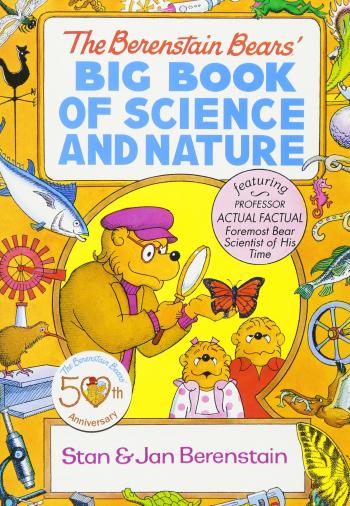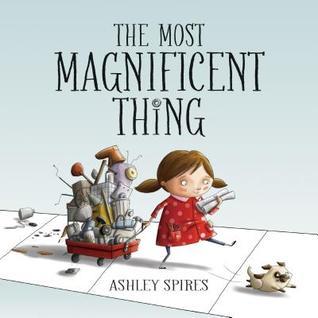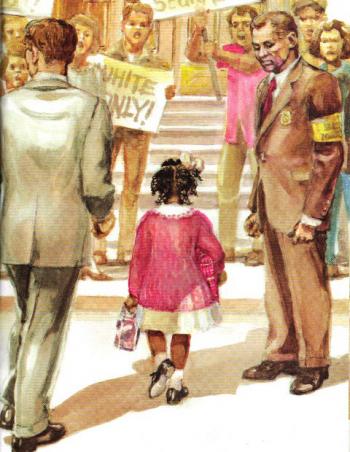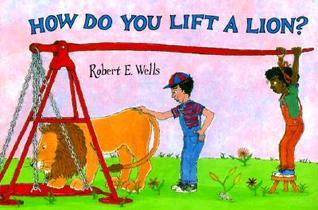
scrounge: /skrounj/ informal verb: to actively seek [books] from any available source

The Berenstain Bears' Big Book of Science and Nature has been a very enjoyable and informative read for us. Our four-year-old has asked to read it many times now, after we read it for pre-K.
This book is actually three "books" combined. The first section is the Almanac, which introduces children to the concept of a "year," and all the different changes that take place over the course of it, from major holidays such as New Year's, Independence Day, and Thanksgiving, to seasons and the way the weather changes in each one, and explanations of major weather events like thunderstorms, wind, and snow.
The second section is the Nature Guide. This gives an overview of all the different kinds of life on our planet, as well as non-living things like rocks and other geographical features. From fish to mammals to plants and insects, the bears (with Papa as tour guide) experience a little bit of just about everything!
The last section is the Science Fair, which I found to be a bit more detailed than the others, but still just as fun. We learn about simple machines, matter (including the three states of solid, liquid, and gas), and energy. Included are a few easy science experiments that children and adults can do at home to help demonstrate some of these ideas.
Even though it's instructive, the book manages to rhyme well in each section, which adds to the fun of reading.
Scrounged From: Amazon (used)
Format: Paperback
Authors/Illustrators: Stan and Jan Berenstain
Pages: 192
Content Advisory: None

The Most Magnificent Thing is a great picture book for children that encourages them to see the value in failure. It's not very long, but it manages to express a lot in the space it has, plus the illustrations are cute.
It's the story of a girl who wants to build something magnificent. She knows how she wants it to turn out, but none of her attempts produce the result that she's looking for. She gets frustrated, and her dog (who is also her best friend) suggests going for a walk. When she gets back, the girl is more focused, and manages to see that all of her failures had some redeeming qualities in them, which helps her to make her truly magnificent thing.
This story can give an especially helpful perspective to those who are perfectionists, but there is probably something here for all of us.
Scrounged From: Amazon (a birthday present for our two-year-old)
Format: Hardcover
Author/Illustrator: Ashley Spires
Pages: 32
Content Advisory: None

Book Scrounger's note: The following is a guest review by Doug, a.k.a. Professor Puzzler.
The Story of Ruby Bridges is a children's book which tells the story of the desegregation of William Frantz Elementary School in New Orleans. The story focuses primarily on Ruby's bravery, her faith, and her desire to find forgiveness for the mobs of angry people who wanted to stop her from attending the school.
Speaking of the mobs, author Robert Coles does an excellent job of describing the troubles that Ruby faced, at an age-appropriate level for a children's book. He speaks of angry mobs, and shouting, and protest signs, and of people wanting to hurt Ruby, but avoids discussing any of the specifics of the threats she faced. I liked this choice on the author's part, as it gives parents the freedom to discuss the more vicious aspects of the story when they feel it is most appropriate for their own children.
Robert Coles was probably best suited of anyone to write this book, as he was the child psychiatrist who met weekly with Ruby during her first year at Frantz Elementary. His work with Ruby led him, eventually, to write a book titled Children of Crisis: A Study of Courage and Fear, which he eventually developed into a series of books that won him the Pulitzer Prize in 1973.
Of course, any children's book is dependent not just on the author, but also on the illustrator; an illustrator can make or break a book. In this case, George Ford is an integral part of making this book a success. The illustrations are beautiful, with great use of light, shadow and coloration to draw attention to the focus of the book -- Ruby herself. Whether she is sitting alone in a classroom, with her family at church, or dwarfed by an angry mob and the marshals protecting her, it is always Ruby that captures your eye.
Scrounged From: Our local library
Format: Hardcover
Author: Robert Coles
Illustrator: George Ford
Pages: 32
Content Advisory: Thematic elements, as described above.

A Child's Book of Art helps introduce young children to art history, or even just art in general, using relatable categories such as pets, family, outdoors, etc. This is one of the largest books we have, and so the pictures are big and easy for children to inspect carefully if they feel like it.
Each category includes several paintings from a large range of time periods and painters. Art history can also become a discussion about history in general, as children get to see portraits of children their age dressed very differently!
Even though I'm not much of an "art person," I still enjoy reading this book with my kids. I recognized a name here and there, and maybe even learned something myself.
Scrounged From: AbeBooks.com
Format: Hardcover
Author: Lucy Micklethwait
Pages: 64
Content Advisory: Fairly clean for art history, but some barely noticable nudity in a couple places.
This is a fun and informative series of books, written and illustrated by Robert E. Wells, that helps introduce some basic science concepts to children. They are geared mainly toward pre-kindergarten through third grade, but they can be enjoyed by any age.

Our favorite of the ones we've read is How Do You Lift a Lion? which introduces simple machines such as the lever, wheel, and pulley. The illustrations are clear and clever, and show how a lion could be lifted if you had enough leverage. We are also shown how to pull a panda on a pallet, and how it could be possible to deliver a big basket of bananas to a baboon birthday party using pulleys.
Is a Blue Whale the Biggest Thing There Is? is another entry in the series. Here we are shown progressively bigger things from whales to earth to stars, until we get to the size (or what is known of it) of the whole universe! You definitely feel small after reading this book, and the illlustrations are very amusing at times (such as a crate of "sun-sized oranges" to demonstrate how our sun compares in size to a red supergiant).
What's Smaller Than a Pygmy Shrew? covers the same idea, but getting progressively smaller, from a shrew to a ladybug to protozoa and protons. This one may be harder to wrap one's mind around, but does a great job of helping us to visualize the idea that there is a whole kingdom of living organisms that are too small for our eyes to see.
We also enjoy What's Faster Than a Speeding Cheetah? which shows us many things that are faster than a cheetah, such as a peregrine falcon, a rocket, and a meteoroid.
These are the only titles we've read so far, but there are several others that sound just as interesting, such as Why Do Elephants Need the Sun?


